Should you get a guitar with a 3 vs 6 saddle Telecaster bridge? It really depends on the sound and playability you like best. In this article, I’ll reveal all the differences between the two bridge types!
You can use the table of contents below to take you to the area that interests you. Click on the little box to open it and then click on the section of the article you want to read, or you can read from start to finish if you want the full Telecaster bridge experience!
The Short Answer
The type of Telecaster bridge (three vs. six-saddle) can change your guitar’s look, sound, and playability. 3-saddle bridges have a vintage look with more twang and sustain, but they are less adjustable and more challenging to intonate. 6-saddle bridges have a modern look and are more adjustable with accurate intonation, but they have less twang and sustain. One bridge type isn’t clearly better than the other. It’s a matter of personal taste.
Keep On Reading (Below) To Learn More
What Are The Basic Differences: 3 Vs. 6 Saddles?
Before I discuss this, let me tell you what a bridge saddle is and why it’s important. If you already know about saddles, you can click here to skip to a bridge comparison table.
What Is A Bridge Saddle?
Guitar strings are supported by the nut at one end of the neck, and the bridge saddles on the guitar’s body. Bridge saddles allow the strings to vibrate and transfer these vibrations into the wood.
On a Telecaster, each saddle can be moved in two directions. Front-to-back movement adjusts string intonation. Up and down motion adjusts the string height from the bridge surface, also known as the “action.”

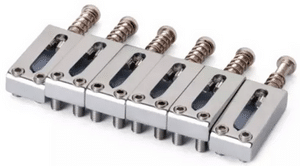
3-Saddle Tele Bridge (Vintage-Style)
The 3-saddle Tele bridge was the original configuration on the Fender Broadcaster guitar produced in 1950 and used on all Nocaster and Telecaster guitars until the mid-’80s when 6-saddle bridges made their appearance.
Each of the three saddles holds two strings, so the intonation and height of each string are not individually adjustable.
The strings are placed on the bridge saddles by putting them through individual holes on the back of the guitar, giving rise to the “string-through-the-body” design. You can see the string holes at the end of the bridge plate in the photo below.
Later, 3-saddle Tele bridges were designed with the option to load the strings through the front of the guitar by placing them directly into the bridge (top-loader design).
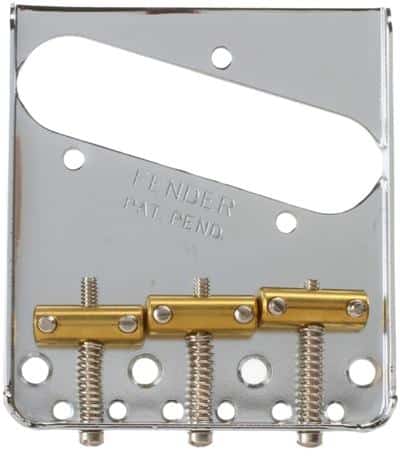
6-Saddle Tele Bridge (Modern Style)
The more modern 6-saddle Tele bridges began appearing in the mid-1980s on guitars like the American, American Deluxe, and American Standard series Telecaster guitars.
The idea was to give each of the six strings its own intonation and height adjustment.
The 6-saddle Tele bride was not originally designed as a “string-through-the-body” setup, but that option was added later.
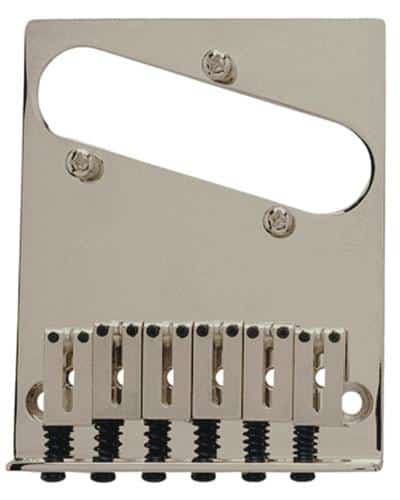
Telecaster Bridge Saddle Comparison

Here is a quick comparison of some differences between the two types of Telecaster bridges. Note that these are typical observations and don’t apply to every guitar.
| Comparison | 3-Saddle Bridge | 6-Saddle Bridge |
|---|---|---|
| Appearance | Vintage (Old School) | Modern |
| String Adjustment | In Pairs | Individually |
| String Through The Body | More Common | Less Common |
| Tone | More “Twang” | Less “Twang” |
| Intonation | Less Accurate | More Accurate |
| Sustain | More | Less |
| Action (String Height) | Less Adjustable | More Adjustable |
| Saddle Material | Chrome, Steel, Brass, Titanium, Graphite | Chrome, Steel, Brass, Titanium, Graphite |
| Cost | Variable | Variable |
Keep On Reading (Below) To Learn More About Each Item
Overall Appearance
The type of bridge saddle can make a big difference in the overall appearance of a Telecaster. 3-saddle bridges give a guitar that vintage, old-school vibe, while six individual saddles conjure a more modern look.
Even a heavy relic guitar with a 6-saddle bridge can look wrong and draw criticism from players familiar with vintage Telecasters!
Take a look at this ’52 heavy relic Tele made by the Fender Custom Shop. It’s practically begging for a 3-saddle bridge, and that’s why it has one! A heavy-reliced 6-saddle bridge would not have looked right. I doubt you could even talk a custom shop master builder into putting a 6-saddle bridge on this guitar. Well, maybe for the right money you could, but don’t do it!

I’m all-in when it comes to using 6-saddle bridges and on non-vintage modern Teles, although there are some possible tradeoffs, including tone and sustain. Keep reading, and I’ll explain why.
Tone
The type of Tele bridge can have a significant effect on tone. Most of the energy transferred from a vibrating string into a guitar’s body comes from the bridge and saddle type, its setup, and the string gauge.
First of all, 3-saddle bridges tend to have more of that “twang” that Teles are known for, while the 6-saddle bridges have a more balanced tone with less twang.
Cold-rolled steel Tele bridge plates and bigger (heavier) bridge saddles can improve tone.
Bridge Saddle Material Matters
Tele bridge saddles are available in various materials, including Chrome, Steel, Brass, Titanium, and Graphite. Brass is more popular for 3-saddle bridges, while steel is more often seen in the 6-saddle configuration.
Brass saddles give a warmer and fuller tone. Steel saddles can be nickel or chrome plated, and both sound brighter than brass. Be aware that chrome-plated saddles are harder than nickel-plated steel and can break thins strings easier, especially during wide string bends.
Stainless steel saddles are also available, which have “sweeter-sounding” harmonics with more attack in the high end and are punchier in the low register. Jeff Beck likes stainless steel saddles on his Strats.
Titanium saddles have a unique chime that adds brightness to the high notes and tightens up the low end of a dark-sounding guitar. I favor titanium and have installed these saddles on many of my Teles.
The bottom line is that you have to experiment with different saddle materials to find the ones that best complement the tone of your guitar. You may end up using more than one type of saddle material on the same Tele to balance the sound of a particular string or two.
See Titanium Guitar Saddles – Make Your Guitar Sound Fantastic! for more info.
Intonation
Intonation is the process of adjusting the Telecaster bridge saddles to make notes sound in tune all over the guitar neck.
The problem with the 3-saddle Tele bridge is that the intonation for the six strings has to be adjusted in pairs. So the E & A, D & G, and B & E strings must be adjusted together.
When Fender introduced the Stratocaster guitar in 1954, they corrected this problem with a new 6-saddle bridge so that the intonation for each string could be adjusted individually. Still, Fender did not offer the 6-saddle Telecaster bridge until the mid-1980s.
So, why are the 3-saddle Tele bridges still popular on guitars being made today? The reason is that they can have other advantages like better tone and sustain and a vintage look.
What About Compensated Bridge Saddles?
To help improve intonation, some Tele players began bending the bridge screws to angle the three saddles to compensate for the problem. Eventually, Fender and other third-party parts manufacturers started offering “compensated” bridge saddles pre-installed on Telecasters and available separately as bridge upgrades.
Compensated bridge saddles are a must for any Telecaster. Even players with vintage Teles use them and keep the original saddles safely tucked away to retain the guitar’s resale value.
All my 3-saddle Teles are equipped with a compensated bridge. Here are the ones I use in vintage brass, which are simple to install and sound excellent! You can check them out on Amazon by clicking on the link below.
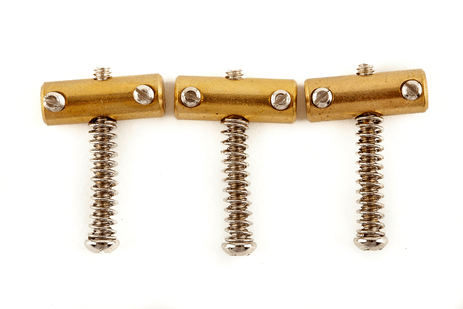
Click HERE to check the price and reviews on Amazon.
Sustain
The type of bridge and bridge saddles you use can significantly affect your Tele’s sustain. Here are some key points to consider.
Saddle Size, Material, And Number Matters
The size (mass) and material of the saddles on a Tele can make a difference in sustain.
Generally speaking, I find that the heavier bridge saddles on the 3-saddle bridges have better sustain, while the lighter 6-saddle bridge configuration has less sustain. This is not exclusively true, but it’s a good rule of thumb.
Does The Bridge Plate Make A Difference?
Yes, the bridge plate thickness, material, and manufacturing process can affect the sustain.
I like using Glendale Vintage “Blackguard” cold rolled steel bridge plates for my 3-saddle setups, which really give me good sustain with a very balanced but classic Tele twang!
For 6-saddle setups, I favor the sustain and sound of the Gotoh chrome bridge plates.
Is String Through The Body Better?
When it comes to sustain, a string through the body setup is the way to go. Teles that are strung from the back vibrate the guitar’s body more efficiently and create noticeably more sustain!
This is probably the most important contributing factor to sustain.

Teles with a “top-loader” (non-string through the body) design make string changing more convenient, but usually at the expense of sustain (and tone).
Action (String Height)
In a 3-saddle bridge, each saddle has two screw adjustments to raise and lower each string, but adjusting one side of the saddle affects the height of both strings to a certain extent.
The other big advantage of a 6-saddle bridge (besides better intonation) is the ability to adjust each string height (action) separately to make the guitar easier to play with string buzz.
The string height and intonation advantages make the 6-saddle bridge a popular choice among modern Telecasters.
What About Cost?
The cost of a three versus six-saddle Tele bridge is more a factor of material and design quality than the number of saddles.
You can buy reasonably priced bridges in both saddle configurations, so cost is typically not a factor.
So, Which Is Better, Three Or Six Saddles?
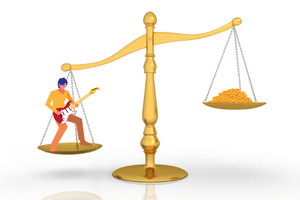
There is no clear winner in the three versus six saddle Tele debate. However, Tele “purists” prefer the 3-saddle design, and I’m one of them. I love the classic sound of a Tele with three brass saddles, string through the body design, and a bone nut!
Whatever saddle configuration sounds and plays best for you is the setup you should go with. If you’re buying a second Tele, you might consider having one of each type.
Can You Exchange One Bridge For Another?
Yes, it is possible to exchange a 3-saddle bridge for a 6-saddle configuration and vice versa. You can also change the bridge from a string through the body to a top-loading design.
If you change the bridge plate on a vintage Tele, be sure that the mounting screws of the new plate line up perfectly with the holes in the body, and be sure to keep the old (vintage) bridge plate and saddles.
Any permanent modification to your guitar can lower its resale value!
Are You Qualified To Make Guitar Adjustments Or Modifications?
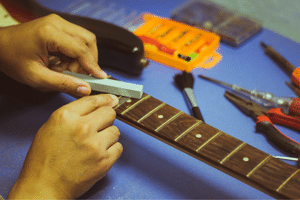
It’s great to work on your guitars, especially if you have a lot of them, but you should always be aware of your limitations.
Adjusting things like an electric guitar’s string height (action) or pickup height can be straightforward. Still, some adjustments require the proper training and experience, like adjusting a guitar’s truss rod.
Don’t attempt to change the bridge plate or saddles on your Telecaster unless you feel comfortable doing so!
When you doubt your ability to adjust, repair, or modify your guitar, it’s always best to bring it to a competent guitar technician or luthier (guitar designer & builder). You can permanently damage your guitar, and it might never play and sound right again!
Making modifications to your guitar can void its manufacturer’s warranty and cause permanent damage to the instrument. Certain modifications are irreversible, so you may be stuck with them, even if you desperately want to restore the guitar to its original condition!
I learned that the hard way over the years until I did a three-year apprenticeship in a guitar repair shop. Now I have my own home workshop with the proper training and equipment to safely maintain and repair all my instruments.
Remember: “When In Doubt, Send It Out!”
Frequently Asked Questions

Here are some of the questions I get asked about Telecaster bridges.
If your question does not appear here, please put it in the comments, and I will get right back to you with an answer.
Why Is The Telecaster Bridge Pickup Slanted?
The Telecaster bridge pickup is slanted to be closer to the thinnest (treble) strings. This helps give the Tele a more twangy sound. The amount of twang can also be adjusted by raising and lowering the pickup.
What Gives A Telecaster Twang?
The Telecaster gets its twang from the bridge plate, saddles, and bridge pickup.
How Do You Ground A Bridge On A Telecaster?
The bridge of a Telecaster can be grounded to help improve hum by attaching a ground wire underneath the bridge plate near one of the bridge screws.
Should The Bridge Pickup Be Louder Than The Neck Pickup?
No, it’s best to balance the height of both pickups, so they are approximately the same volume. Set the bridge pickup height to give you the best sound, and then adjust the neck pickup to match its volume.
Do I Need To Loosen The Strings Before Adjusting Intonation?
Yes, it’s always best to loosen the strings before adjusting the guitar’s intonation (and action) to avoid damaging the saddles and saddle screws.
Do You Have To Intonate Every Time You Change Strings?
No, you don’t need to reset the intonation when you change strings. However, if you change the string gauge or string type, the guitar may need to be intonated.
Final Thoughts

I hope you found this 3 Vs 6 Saddle Telecaster Bridge article helpful. There are clear differences between the two bridge types that can change the sound and playability of a Telecaster!
The 3-saddle bridges have a more “old-school” vintage look with more twang that many players find iconic. They also tend to have better tone and sustain, but intonation can be challenging. These bridges may also be difficult to precisely adjust the action the way you like it.
“Compensated saddles” are available, which improve the intonation on 3-saddle bridges.
The 6-saddle bridges have a more modern look and can be properly intonated, but they tend to have less twang and sustain. Each string’s action (height) can be precisely adjusted to help give a better playing experience.
The bridge plate and saddles are available in a variety of materials. Saddles come in chrome, steel, brass, titanium, and graphite. These materials can affect both tone and sustain.
There isn’t a “best bridge configuration” for a Telecaster. Some players prefer three saddles, while others like six. Get the one that sounds and plays best for you.

Check out this video, which compares the sound of a three versus a six-saddle bridge using the same Tele!
What To Read Next ➡ What Genre Is A Telecaster Good For? (It’s Not Just Country)
Tell Me What You Think

Please leave a comment below if you enjoyed this article, have any questions about Telecaster bridges, or want to give your point of view. I will be happy to help you.
- Which bridge does your Tele have, three or six-saddle? What do you like or dislike about it?
- Were you aware that a Tele can have two different bridge types?
- Did this article help you decide which bridge saddle type would be best for you?
- What else is on your mind?

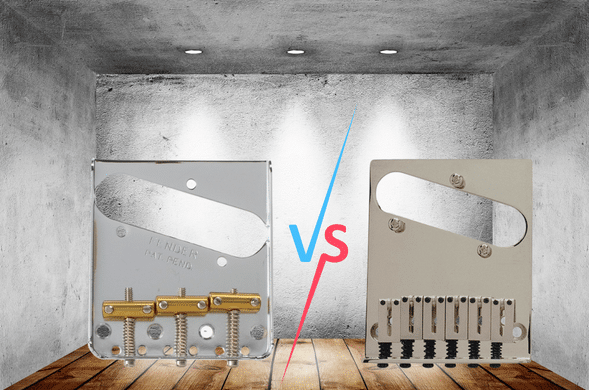

Wow! Great article – this is extremely informative and really helped me better understand a subject that I had little understanding about. I’ve always found the guitar fascinating but had a hard time understanding so many aspects of it. This really broke down this particular subject for me. Thanks so much!
Hi, Marissa
Thank You for your comments!
It can get a little complicated from a design point of view.
So glad you enjoyed the article!
Frank 🎸
Just bought a 2006 tele. was debating about three saddle (mainly for the looks) but this great piece of review work has convinced me to leave the six saddle on. Thanks for this.
Hi, Eric
Yeah, I agree. The three-saddle Tele bridges have that “vintage” look and sound, but you can’t go wrong with a six-saddle setup. With six saddles, you can get the intonation spot-on, which is hard to do with three saddles, even if they are compensated.
Rock On!
Frank ?
Hi Frank,
Thanks for writing such an in depth article on the differences between 3 and 6 saddles.
One thing that I think is really interesting about guitar set-ups is the fact that, as you say, there’s no single ‘correct’ set-up so it really is a matter of taste. I think that every guitar player should experiment with different set-ups so that they can find what works best for them and what their favourite sound is.
Different types of saddle are a fascinating area of guitar mechanics and I’m certainly going to pay more attention when watching live bands to see if I can spot what saddle type is being used and how it affects the sound.
Thanks again
John
Hi, John
Thank You for your comments!
On a Telecaster, you have the 3 or 6-saddle option. However, on some other guitars, like a Stratocaster, the bridge always has a saddle for each string.
Guitar mechanics are a multi-faceted concept. For example, the guitar nut type can affect a guitar’s sound just as much, if not more, than the bridge saddles.
Frank 🎸
Thanks for the article. I have three T-style guitars with six-saddle string saver saddles and 3 with traditional brass barrel saddles. The difference in tone is vast. The problem with intonation seems to be minimal with the gauge and brand of strings that I use. Even with compensated saddles you often have to split the difference between the two strings. However, there is little to zero difference in string height adjustment. I have no problem at all setting the radius with three saddles. One thing for certain, the Telecaster is THE guitar to be playing!
Hi, Matt
I appreciate your comments!
Three-saddle bridges are great because they have the original Tele sound! I agree that they can be a setup to sound great all over the neck.
I have found that with any guitar, you have to sweeten the tuning between certain strings, which is fine. I learned how to do this many years ago from a piano tuner. ?
Rock On! ?
Frank ?
Fender actually started offering a six saddle Telecaster bridge as far back as the mid seventies.
Thanks for your comment, Larry!
Best
Frank